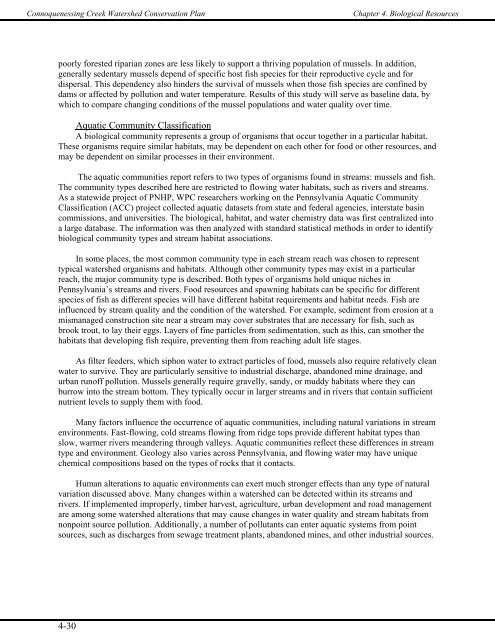CHAPTER 4 - Western Pennsylvania Conservancy
CHAPTER 4 - Western Pennsylvania Conservancy
CHAPTER 4 - Western Pennsylvania Conservancy
You also want an ePaper? Increase the reach of your titles
YUMPU automatically turns print PDFs into web optimized ePapers that Google loves.
Connoquenessing Creek Watershed Conservation Plan<br />
Chapter 4. Biological Resources<br />
poorly forested riparian zones are less likely to support a thriving population of mussels. In addition,<br />
generally sedentary mussels depend of specific host fish species for their reproductive cycle and for<br />
dispersal. This dependency also hinders the survival of mussels when those fish species are confined by<br />
dams or affected by pollution and water temperature. Results of this study will serve as baseline data, by<br />
which to compare changing conditions of the mussel populations and water quality over time.<br />
Aquatic Community Classification<br />
A biological community represents a group of organisms that occur together in a particular habitat.<br />
These organisms require similar habitats, may be dependent on each other for food or other resources, and<br />
may be dependent on similar processes in their environment.<br />
The aquatic communities report refers to two types of organisms found in streams: mussels and fish.<br />
The community types described here are restricted to flowing water habitats, such as rivers and streams.<br />
As a statewide project of PNHP, WPC researchers working on the <strong>Pennsylvania</strong> Aquatic Community<br />
Classification (ACC) project collected aquatic datasets from state and federal agencies, interstate basin<br />
commissions, and universities. The biological, habitat, and water chemistry data was first centralized into<br />
a large database. The information was then analyzed with standard statistical methods in order to identify<br />
biological community types and stream habitat associations.<br />
In some places, the most common community type in each stream reach was chosen to represent<br />
typical watershed organisms and habitats. Although other community types may exist in a particular<br />
reach, the major community type is described. Both types of organisms hold unique niches in<br />
<strong>Pennsylvania</strong>’s streams and rivers. Food resources and spawning habitats can be specific for different<br />
species of fish as different species will have different habitat requirements and habitat needs. Fish are<br />
influenced by stream quality and the condition of the watershed. For example, sediment from erosion at a<br />
mismanaged construction site near a stream may cover substrates that are necessary for fish, such as<br />
brook trout, to lay their eggs. Layers of fine particles from sedimentation, such as this, can smother the<br />
habitats that developing fish require, preventing them from reaching adult life stages.<br />
As filter feeders, which siphon water to extract particles of food, mussels also require relatively clean<br />
water to survive. They are particularly sensitive to industrial discharge, abandoned mine drainage, and<br />
urban runoff pollution. Mussels generally require gravelly, sandy, or muddy habitats where they can<br />
burrow into the stream bottom. They typically occur in larger streams and in rivers that contain sufficient<br />
nutrient levels to supply them with food.<br />
Many factors influence the occurrence of aquatic communities, including natural variations in stream<br />
environments. Fast-flowing, cold streams flowing from ridge tops provide different habitat types than<br />
slow, warmer rivers meandering through valleys. Aquatic communities reflect these differences in stream<br />
type and environment. Geology also varies across <strong>Pennsylvania</strong>, and flowing water may have unique<br />
chemical compositions based on the types of rocks that it contacts.<br />
Human alterations to aquatic environments can exert much stronger effects than any type of natural<br />
variation discussed above. Many changes within a watershed can be detected within its streams and<br />
rivers. If implemented improperly, timber harvest, agriculture, urban development and road management<br />
are among some watershed alterations that may cause changes in water quality and stream habitats from<br />
nonpoint source pollution. Additionally, a number of pollutants can enter aquatic systems from point<br />
sources, such as discharges from sewage treatment plants, abandoned mines, and other industrial sources.<br />
4-30














